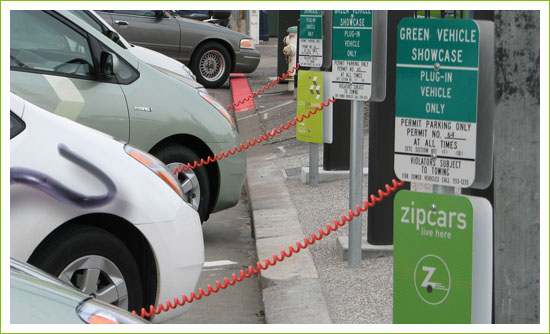Infrastructure for EV's
Electric vehicle owner will need to charge their vehicles both at home and away from home.
Watch this video to learn about charging at home and in the public space:

Based on a typical use pattern for a family car 80 % of the charging could be done at home. The technology for home charging is relative straight forward if the vehicle is parked in a private garage. A private charging station is inexpensive and easy to install. But it's not that simple!

Figure 25: A Level 2 home charging station is quite simple and inexpensive
Unrestricted home charging could cause serious problems for the public electric grid. The charging load would be concentrated in the afternoon hours where the grid is already heavily loaded. To avoid this charging must be coordinated so that the charging load is distributed more evenly and most importantly the main portion of charging must take part at night.
Such intelligent charging networks already exist but they must be encouraged by society. If there is no difference in electricity price the vehicle owner has little incentive to join a charging network or to ensure that his vehicle only charges at night. It is up to authorities, grid operators and utilities to create a legal framework that encourages EV owners to charge in an appropriate way.
Harmful afternoon charging should be counteracted e.g. by intelligent electricity pricing
An even greater challenge is public charging. The possibility to charge in the public space is absolutely crucial for the success of electric vehicles. Without public charging spots the electric car will not be a fulfilling alternative to the conventional car.
The availability of public charging stations is crucial
Along the main roads and highways there should be a charging spot a least for every 50 km. The charging method in these locations should be fast charge and/or battery swap since the available time for stopping is typically short.
Outside typical working places such as office buildings, factories etc. level 2 charging makes sense because there is typically about 8 hours available.
At home level 2 charging is also appropriate for overnight charging.
In busy places such as shopping malls, theatres, post offices charging poles may undesired simply because it would keep the parking spaces occupied for too long. Careful planning is needed.
In airports and other places where parking time is several days a level 2 charging option is also appropriate.
In public parking spaces the average parking time would indicate which kind of charging is needed. If parking time is less than one hour level 2 charging makes little sense.
In the streets of densely populated areas where people live in apartments there is a need for one charging pole for every electric car. The poles should all be connected to intelligent charging networks.

Figure 26: Public charging in the street (picture from Wikipedia)
